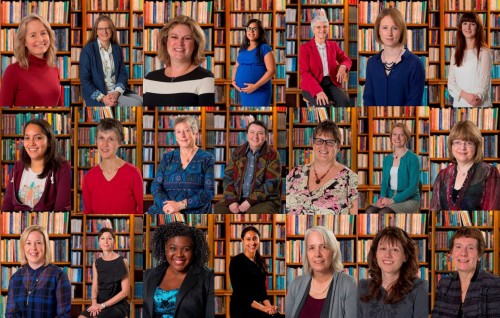Tag archives: astronomers
New constellations, happy birthday Kristian Birkeland, ‘There once was a chemist from Bath…’
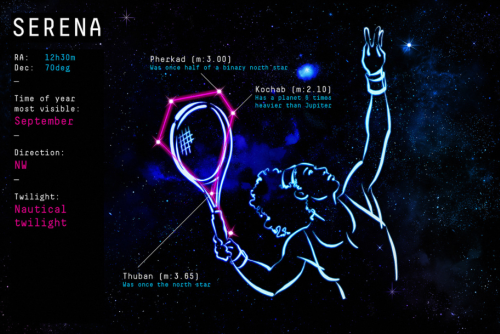
Reach for the stars: constellation Serena (Courtesy: University of Birmingham)
By Hamish Johnston
Astronomers at the University of Birmingham have dreamt-up a set of modern constellations in a bid to inspire young people to take an interest in the cosmos. The constellations are related to eight admirable people including J K Rowling, Usain Bolt, Malala Yousafzai, David Attenborough, Mo Farah and Michael Bond. But my favourite is the tennis racquet shaped constellation Serena, named after Serena Williams.
View all posts by this author | View this author's profile
The September 2017 issue of Physics World magazine is now out
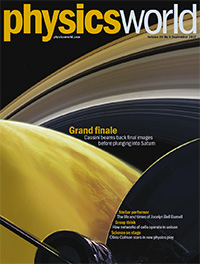 By Matin Durrani
By Matin Durrani
Some of the daily challenges facing women in physics are tackled in the latest issue of Physics World magazine, which is now out.
As well as a round-up from the recent International Conference on Women in Physics, which took place in Birmingham, UK, there’s a fascinating feature about the life of Jocelyn Bell Burnell. She discovered pulsars 50 years ago next month and became the first female president of the Institute of Physics, which publishes Physics World.
As Bell Burnell points out, “Fix the women!” is often seen as the solution to why women progress more slowly in physics than men. In fact, she argues, larger problems – notably institutional bias and poor policies – are to blame.
Don’t miss either our cover feature on the stunning images Cassini has been beaming back over the last few months before it plunges into Saturn on 15 September. We’ve also got a great Lateral Thoughts article by Daniel Whiteson, illustrated by PHD Comics artist Jorge Cham. Plus, find out how groups of cells move, communicate and organize themselves in networks.
Remember that if you’re a member of the Institute of Physics, you can read Physics World magazine every month via our digital apps for iOS, Android and Web browsers.
View all posts by this author | View this author's profile
A big Lidl telescope in Belfast
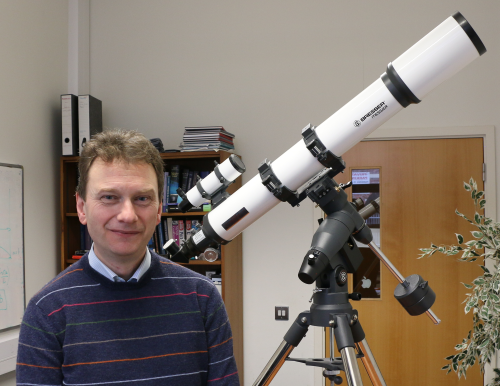
Not so Lidl: Alan Fitzsimmons and his bargain telescope.
By Hamish Johnston
There is an old joke in the UK about going to the discount supermarket Lidl for a pint of milk and coming home with a new set of power tools or ski-wear for the entire family. That’s because the retailer is famous for its seemingly random special offers. One week it could be car accessories and the following week the same shelves could be stocked with pyjamas or camping gear.
But Alan Fitzsimmons of Queen’s University Belfast deserves an award for best physics-related Lidl bargain with this huge telescope that he bought at the supermarket. It makes perfect sense to me – both Lidl and the telescope’s maker Bresser are German companies and, of course, Germany is famous for its optics.
View all posts by this author | View this author's profile
Female astronomers through the ages, science-inspired phone cases and the return of the incandescent light bulb
By Hamish Johnston
The first documented female astronomer in Britain was Margaret Flamsteed (1670–1739), who worked with her husband John at the Royal Observatory in Greenwich. That’s according to astronomer Mandy Bailey of the UK’s Royal Astronomical Society, who has written an article entitled “Women and the RAS: 100 years of Fellowship”. As the title suggests, this year is the centenary of the first women becoming fellows of the RAS.
To celebrate the centenary, the RAS commissioned Maria Platt-Evans to photograph 21 leading female fellows. The portraits appear above and are also presented in the slide show “Women of the Royal Astronomical Society”, which includes short biographies.
Tiny gifts for world leaders, Hubble’s birthday and more
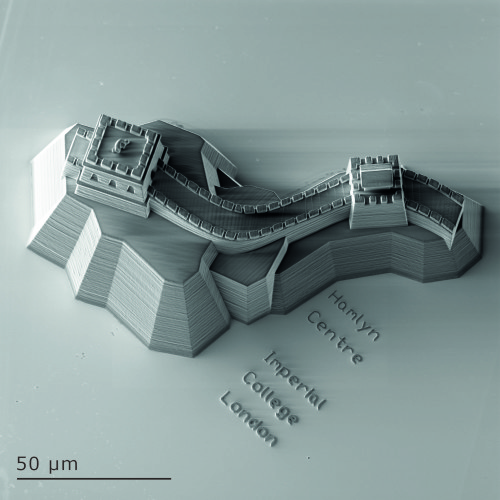
Tiny trophy: The Great Wall of China, printed with a Nanoscribe system at the Hamlyn Centre, Imperial College London. (Courtesy: Nanoscribe)
By Hamish Johnston and Tushna Commissariat
Last month, China’s president Xi Jinping’s was on a state visit in the UK and while here, he toured a few academic institutions, including the UK’s new National Graphene Institute (NGI) in Manchester and Imperial College London. As we reported in an earlier blog, Nobel-prize-winning Manchester physicist Kostya Novoselov presented President Xi “with a gift of traditional Chinese-style artwork, which Kostya himself had painted using graphene paint”. This week we found out that the Imperial scientists also presented him with a “tiny gift” in the form of a 50 µm scale version of a section of the Great Wall of China, imaged above, created with a Nanoscribe 3D printer. Prince Andrew, who was also on the visit, was given an image of a panda leaping over a bamboo cane, which was printed on the tip of a needle.
Quantum mechanics in a cup of coffee, hamming it up to the space station, the laws of political physics and more
By Hamish Johnston and Michael Banks
Physicists tend to drink lots of coffee so I wasn’t the least bit surprised to see the above video of Philip Moriarty explaining quantum mechanics using a vibrating cup of coffee. Moriarty, who is at the University of Nottingham, uses the coffee to explain the physics underlying his favourite image in physics. You will have to watch the video to find out which image that is, and there is more about the physics discussed in the video on Moriarty’s blog Symptoms of the Universe.
How far away can you see light from a candle?
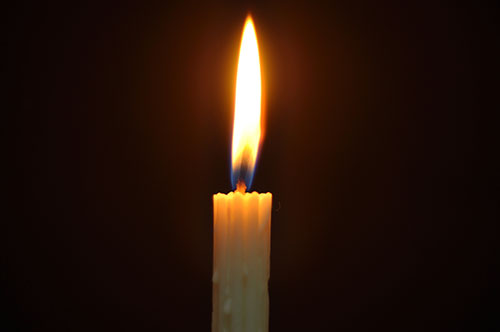
New research looks at the distance from which a candle flame can be seen. (Shutterstock/underverse)
By Andrew Silver
Can the unaided eye see the light from a single candle from 10 miles away? According to some claims on the Internet, the answer is yes – but now two scientists in the US have borrowed techniques from astronomy to show that a pair of binoculars would probably be needed.
The story behind this work began high in the Andes one moonless night when a candle was lit on the Cerro Tololo Inter-American Observatory telescope catwalk. Somebody walked 400–600 m away and said the flame was as bright as the brightest stars in the sky. Nobody wrote down any numbers.
View all posts by this author | View this author's profile
The Dark Matter Garden, gravitational atoms, boys and girls with toys, and more
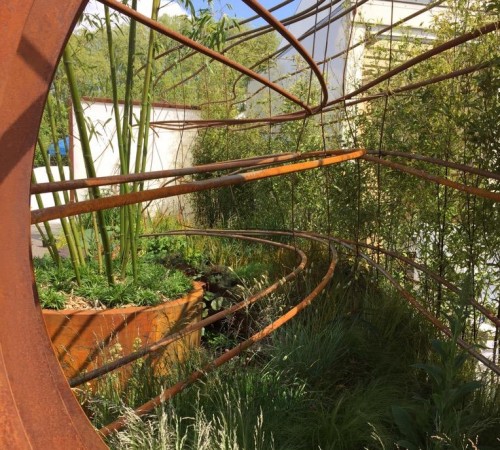
Gravitational gardening: the Dark Matter Garden at this year’s RHS Chelsea Flower Show. (Courtesy: National Schools’ Observatory)
By Hamish Johnston
Gardening is something that the British take very seriously and this week’s RHS Chelsea Flower Show is the pinnacle of that obsession. Indeed, it is so popular that it is covered live on television by the BBC. One highlight of the show is the garden competition, in which designers transform an empty plot into a dazzling garden in just 10 days. This year’s entries include the Dark Matter Garden, which “brings the mysteries of the universe to Chelsea”. That’s the claim of the designers of the garden (including several astronomers), who built it for the UK’s National Schools’ Observatory. The team says that its gold-medal-winning design includes “innovative structures and planting, and represents the effect of dark matter on light”.
Space-station toilet tour, the Louvre’s particle accelerator and more
By Tushna Commissariat
I’m sure that many of us, while watching videos of astronauts on board the International Space Station (ISS), floating around with their halo-like hair, have given much thought to how they shower, wash their hair, brush their teeth and, indeed, poop and pee! Well, you can stop stretching your imagination and take a look for yourself – we spotted this story on the Slate website, where you can see the latest videos from the European Space agency, where Italian astronaut Samantha Cristoforetti, who is currently on the ISS, gives us a tour of both the toilet (above) and the “shower” area (below). She even demonstrates exactly how to wash your hair in space – it looks rather fuss-free if you ask me!
Entangled and stringy videos, a new chat show about the heavens, Hawking and Newton hit the Oregon Trail and more
By Hamish Johnston
This week’s Red Folder begins with a pair of videos that attempt to explain some of the most difficult concepts in physics. First up is a video featuring physicist and filmmaker Derek Muller, who does a lovely job of explaining quantum entanglement with the help of a few cardboard cut-outs and a couple of spinning avatars (see above).
